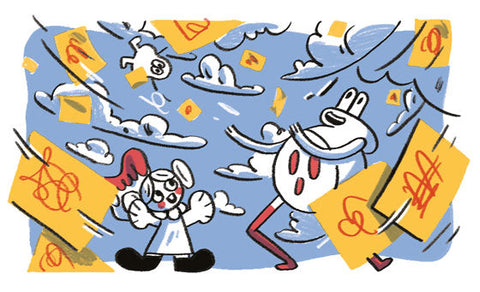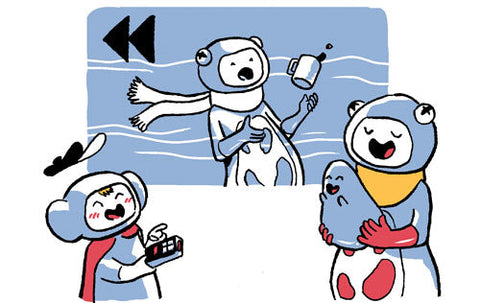ℹ️ Skip to key parts of the session by clicking on the chapter dots along the timeline.
Steve Rawling, Author of Storyteller Tactics, is joined by members of the Pip Decks community to share how to tell your workshop like a story. You’ll notice the headings below match up with the video chapter titles, so you can skim read until you find the bit you want to deep dive into, then watch that chapter of the video.
You’ll notice that this session is hosted by Anamaria at Butter, and run using Butter, which is a virtual collaboration tool with loads of interactive features that makes it really great for virtual workshops. You’ll see a few of those in action during today’s session, including the timed warm-up question (with background music) at the start - watch the Intro to Butter chapter for a little more.
Half the battle of workshops
Steve introduces his background and dives quickly into ‘the problem with workshops…’ - and unsurprisingly, he describes ‘getting people to actually show up’ as half the battle. Especially if they’re voluntary or easily avoided. Trying to get people excited was an ongoing struggle.
Most people in the session don’t get to pull rank and bring people into the room. And even if they do - is that the best way?
Treat your workshop like a story
Whether it’s training, onboarding or road-mapping (some of the examples from the attendees) - you can use a story to help your guests see the point. And your story starts with the very first thing people hear about your workshop. That’s the ‘beginning’ of your story.
So, grab a Storyteller Tactic to get the reason for their attendance across.
Beginning: What’s it About?
The What’s It About? tactic is great for getting buy-in from your audience. It helps you relay a complex topic in short, clear language to get people interested.
The idea of this tactic is to help you deal with the curse of knowledge. That’s what happens whenever you spend a lot of time building up expertise in something, but then have to explain it very quickly to someone who doesn’t have that same knowledge.
There are three ways to describe things in simple terms. Here’s a quick overview - if you think this is what you need to know more about, watch the video for examples and tactics to help you with the next steps for each.
- Change: we don’t pay attention to things that stay the same. Is your workshop in response to an external change/threat? Or is it initiating an internal change/opportunity?
- New information: humans constantly look out for new information - it could help or harm us. Is your workshop about a new realisation, or something that’s not quite right?
- Personal benefit: whatever you’re working on, somewhere along the way there is someone who will benefit (if there’s not, you’ve got a bigger problem!). Are you trying to help a person or people achieve something specific? Are you solving a problem for your attendees?
By following the What’s it About? recommendation for each of these types of workshop, you’ll work out what type of hook to use to grab people’s attention and encourage their attendance.
This part of the session is followed by an activity: the attendees were divided into smaller breakout groups to apply this tactic to their own workshops. Watch the Back in the room chapter of the video to see the discussion at the end of that breakout.
Middle: Man in a Hole
Man in a Hole is a great story structure for complex processes - the middle of your story is the way you plan your workshop. The American Author Kurt Vonnegut said “No one ever lost money by telling the story of a man in a hole”. This tactic relies on the ability of a story about obstacles and struggles to keep people hooked.

Take a look at the story arc: it doesn’t go from bad to good. We start off by thinking we know what we’re doing… and then, we learn that we’re actually not as expert as we thought! But we persevere, and eventually it starts to make sense and have a breakthrough.
Your workshop will walk people along this journey. The attendees start in their comfort zone. The workshop is the trigger for change, but it’s not a case of attending and then everything gets better by itself… in fact, the more they find out, the worse it might seem. That’s the ‘hole’ or crisis. But, while they’re in that hole, they start to find a solution - and that helps you move everyone to a better place than they started, using the knowledge they gained from attending.
Steve challenges the attendees to consider: what are the stages of this process for their particular workshop? What does that initial comfort zone look like? And what is the ‘better place’ you’re promising? And how will your workshop trigger change?
This section of the workshop also features a breakout session, but with time running out we proceed quickly to the third and final tactic.
End: Pitch Perfect
You’ve hooked people in with your first tactic. You’ve taken them on a difficult journey to a better place. Now, as a result, you have insight, a project or a plan. What now? It's time for Pitch Perfect.
This structure helps you explain that outcome and encourage action. It’s a simple pitching structure.
There are two levels here - the first is useful in most situations:
- Basic (elevator) pitch: what the problem you solve for me, how you solve it and why I should trust you.
- Advanced: problem, opportunity, practical steps, promise (POPP). You start with what needs fixing, followed with the opportunities available, then outline the (challenging) practical steps and promise a happy outcome.
Imagine you wake up on New Year’s Day and think: right, this year I’ll get fit. The gym’s brimming with people just like you! Then, on 31st Jan, the gym’s empty (and rich) again. But a personal trainer could use this approach:
- Problem: you are unfit.
- Opportunity: I can help you get fit.
- Practical steps: lots of hard work!
- Promise: stick it out and you’ll create a healthy fitness habit.
If it was good and it was easy, they would be doing it already! The challenge is vital to the credibility of the story.
And that’s it - the three tactics to help you grab attention (and attendees), impress them and enact change.
Q&A
Should we illustrate with closely related examples, or go for something more 'out there'?
Powerful examples are relatable - stuff that reminds the audience of themselves. But that doesn’t mean it has to be related to the topic at hand. People can imagine good examples from other industries! So, it’s up to you.
Use ‘For example’ to introduce your story - if it’s true. Or, use ‘Just imagine’. Again, it’s a micro story (like your example), but it doesn’t need to be true. Plausible yes, but it doesn’t have to be a true story.
How do you use story strategies to eliminate ego and put everyone on a level playing field?
Stories are such a good empathy bridge! “Don’t criticise someone until you’ve walked a mile in their shoes”... well, a story is one way to do that!
So at the start of your workshop, dive straight into a story. “We’re going to walk a mile in the shoes of one of our customers and the problem she has with using our product. This is how it makes her feel”. Talk about just one customer and create a rich portrait of that person, then tell her story. You’ll be surprised at how easily people can empathise with even hypothetical characters - think about Disney Pixar! We empathised with a fish (Finding Nemo).









